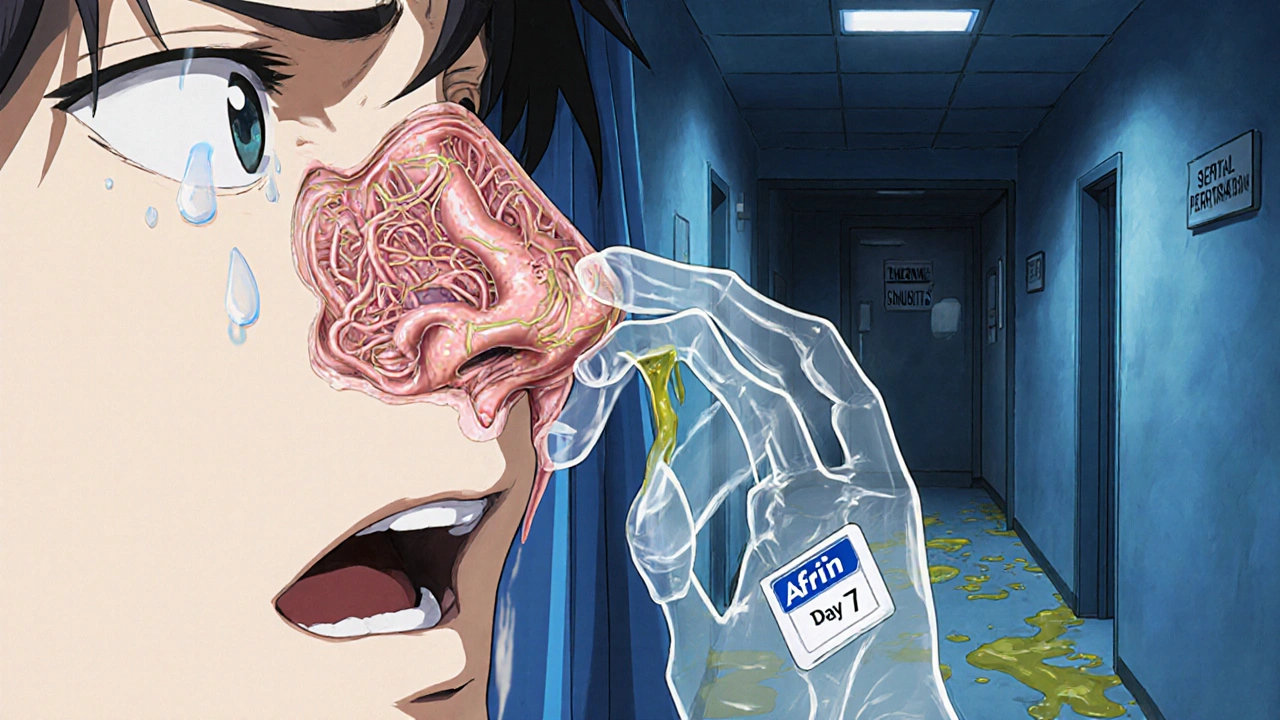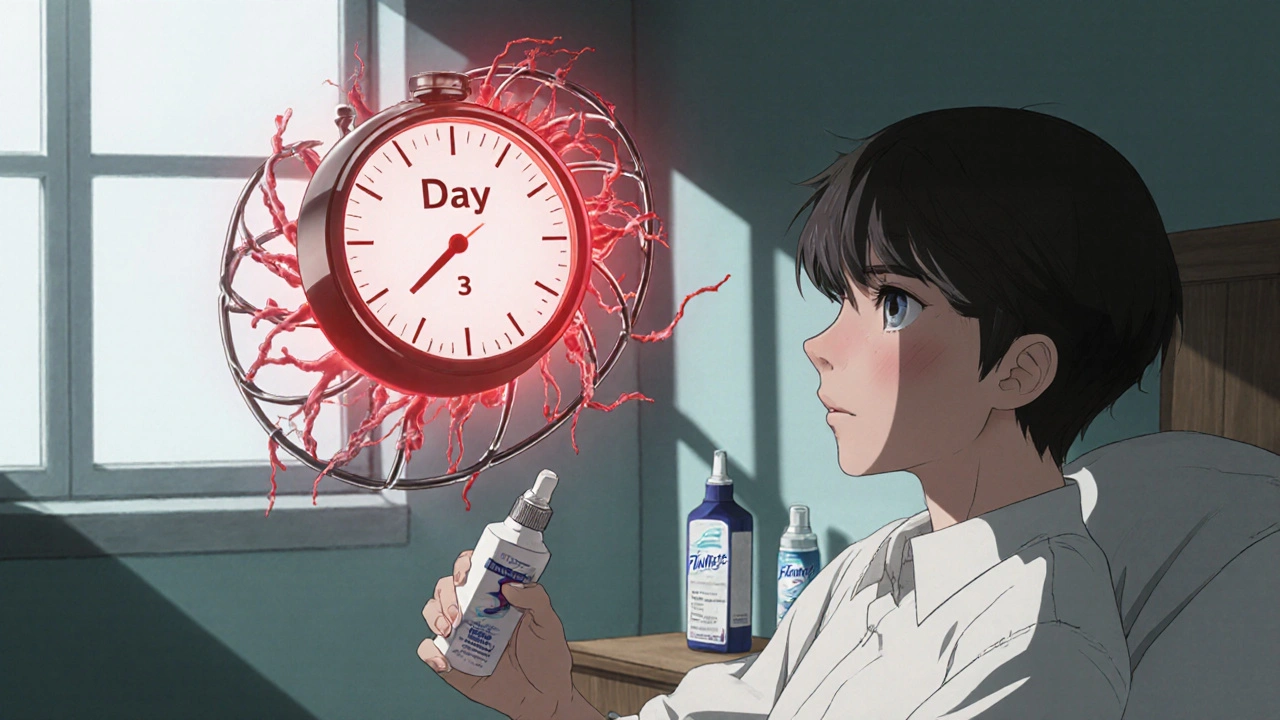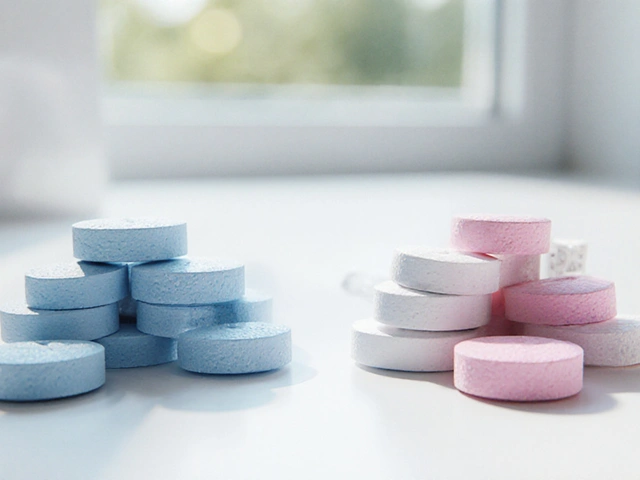Most people reach for an OTC nasal spray the moment they feel that stuffy, blocked-up feeling. It works fast - sometimes in under five minutes. You breathe easier, your head clears, and you feel like yourself again. But here’s the catch: if you use it for more than three days, you might be setting yourself up for something worse than the original congestion. It’s called rebound congestion, and it’s more common than you think.
What Is Rebound Congestion?
Rebound congestion, also known as rhinitis medicamentosa, isn’t just a bad cold coming back. It’s your nose reacting to the spray itself. You use a decongestant spray like Afrin, Neo-Synephrine, or a store brand, and it shrinks the swollen blood vessels in your nose. That’s why you feel relief. But when the medicine wears off - usually within 8 to 12 hours - those blood vessels don’t just return to normal. They swell even more than before. Your nose feels more blocked than it did before you used the spray. So you use it again. And again. Soon, you’re spraying six or eight times a day just to breathe.This isn’t an allergy. It’s not a sinus infection. It’s your body becoming dependent on the spray. The American Academy of Otolaryngology says about 1 to 2% of the general population ends up with this condition. But among people who use decongestant sprays regularly, the risk jumps to 8-10% per year. And once it starts, it can take weeks to recover.
How Do These Sprays Work?
OTC nasal decongestants contain chemicals like oxymetazoline, phenylephrine, or xylometazoline. These are alpha-adrenergic agonists - fancy words for substances that tighten blood vessels. When you spray them into your nose, they cause the blood vessels in your nasal lining to shrink. Less swelling = easier breathing. It’s simple, fast, and effective.But here’s the problem: your body adapts. After just 72 hours of continuous use, the receptors in your nasal tissue start to get tired of the constant stimulation. They become less responsive. To get the same effect, you need more spray. And when you stop, your blood vessels go into overdrive, dilating more than they ever did before. That’s the rebound.
Some brands claim their formula is “less likely” to cause rebound. But the NIH’s StatPearls database confirms cases of rebound congestion have been documented with all major active ingredients, including oxymetazoline - the most common one in today’s sprays. So even if you’re using a “mild” version, you’re not immune.
The 3-Day Rule Isn’t a Suggestion - It’s a Medical Limit
Every OTC nasal spray sold in the U.S. and Australia has a warning on the label: “Do not use for more than 3 days.” That’s not there because manufacturers want to sell you more bottles. It’s there because science proves it’s dangerous after that point.Doctors at Houston Methodist and the Mayo Clinic both say rebound congestion can start as early as day three. By day five, the risk is real. By day seven, you’re likely already in the cycle. Cleveland Clinic data shows 68% of people who develop rebound congestion experience symptoms for 7 to 10 days after stopping - even if they never used the spray again.
Think of it like this: you wouldn’t take a painkiller every hour for a week because you know your body will start needing more just to feel normal. Nasal sprays work the same way. Your nose isn’t broken - it’s just been tricked into thinking it needs the drug to function.

What Happens If You Use Them Too Long?
Using nasal sprays beyond three days doesn’t just make you congested - it can damage your nose. Long-term misuse has been linked to:- Chronic sinusitis
- Thinning of the nasal lining
- Increased risk of nosebleeds
- Permanent changes to nasal blood vessels
- In rare cases, septal perforation (a hole in the wall between your nostrils)
One case study from the University of Rochester Medical Center followed a patient who used oxymetazoline daily for 14 months. By the end, their nasal tissue was so damaged they needed surgery to repair it. That’s not a rare outcome - it’s a predictable one.
And here’s the worst part: many people don’t realize what’s happening. They think their allergies are getting worse, or they’ve caught another cold. They keep spraying. The cycle gets worse. By the time they see a doctor, they’re stuck in a loop that takes weeks to break.
What Should You Use Instead?
You don’t need to suffer through congestion without relief. There are safer, long-term options.Saline nasal sprays - the kind with just salt and water - are completely safe to use every day. They don’t shrink blood vessels. They just flush out mucus, allergens, and irritants. You can use them as often as you want. A NeilMed Sinus Rinse or similar product costs less than $15 and lasts months.
Flonase, Nasacort, or other steroid sprays - these are now available over the counter. Fluticasone propionate (Flonase Sensimist) is one of the most common. It doesn’t give you instant relief. It takes 3 to 7 days to work. But once it does, it reduces inflammation at the source. No rebound. No dependency. Just steady improvement. It’s the gold standard for chronic congestion from allergies or non-allergic rhinitis.
Oral decongestants like pseudoephedrine (Sudafed) can help too - but they’re not for everyone. They raise blood pressure and heart rate. If you have high blood pressure, heart disease, or thyroid problems, avoid them. Check with your pharmacist first.
And don’t forget: hydration helps. Drink water. Use a humidifier. Sleep with your head elevated. These simple steps reduce swelling naturally.
How to Break the Cycle If You’re Already Stuck
If you’ve been using nasal spray for more than three days and your nose feels worse when you stop - you’re not alone. Here’s how to get out of it:- Start a steroid spray immediately. Begin using Flonase or Nasacort once daily, even if you’re still using the decongestant. It takes a few days to kick in, but it’s your best tool to calm inflammation.
- Switch to saline sprays. Use saline 4 to 6 times a day to keep your nasal passages moist and clear.
- Taper off the decongestant. Don’t stop cold turkey. Reduce your sprays by one application every 48 hours. For example: if you’re spraying 4 times a day, go to 3 for two days, then 2 for two days, then 1, then stop.
- Expect discomfort. Days 2 to 5 after stopping will be the hardest. Your nose will feel blocked. That’s normal. It’s your body adjusting. Stick with the steroid spray and saline. Don’t give in to the urge to spray again.
- Be patient. Full recovery takes 7 to 21 days. If you stop abruptly, it could take up to six weeks. Tapering helps, but it still takes time.
Reddit communities like r/Allergies are full of stories like this: “I thought my allergies were getting worse - turns out it was the Afrin.” One user said it took three weeks of daily saline rinses and Flonase to feel normal again. Another said, “I cried because I couldn’t breathe. I didn’t know it was the spray.”

Why Do So Many People Keep Using Them?
The problem isn’t just ignorance. It’s marketing. These sprays work too well in the short term. You feel amazing for a few hours. The packaging says “fast relief.” The label warning is small. Most people don’t read it.Plus, there’s confusion between symptoms. If you have allergies, you might think the spray is helping your allergies. But decongestant sprays don’t treat allergies - they only mask congestion. Steroid sprays do. That’s why so many people use them for months, thinking they’re treating the root cause.
And let’s not forget: these products are everywhere. Drugstores, gas stations, online retailers. They’re cheap. They’re easy to grab. No prescription needed. That convenience makes it easy to fall into the trap.
What’s Being Done About It?
The FDA has required the “3-day warning” on labels since 2002. But studies show 38% of users still go beyond that. In 2023, the FDA discussed adding stronger warnings - maybe even graphic images of damaged nasal tissue - but no changes have been made yet.Some ENT specialists now recommend starting a steroid spray on day two if you know you’ll need decongestants for more than a few days. That way, when you stop the spray, your nose is already being treated with something safe.
There’s talk about developing sprays with built-in usage limiters - like a lockout after three days - but nothing like that exists yet.
Bottom Line: Use Smart, Not Hard
OTC nasal sprays are great tools - if you use them the right way. They’re not meant for daily, long-term use. They’re meant for quick relief during a cold, a flight, or a sudden allergy flare-up.If you have chronic congestion - stuffiness that lasts weeks or months - you’re not dealing with a simple cold. You likely have allergies, non-allergic rhinitis, or another underlying issue. The solution isn’t more spray. It’s seeing a doctor, getting tested, and using the right treatment: steroid sprays, antihistamines, or allergy shots.
Don’t let convenience cost you your breathing. Three days is the limit. After that, it’s not helping - it’s hurting. Switch to saline. Start a steroid spray. Give your nose a chance to heal. Your future self will thank you.





man i used afrin for like 3 weeks straight last winter because i thought my allergies were just being extra dramatic and wow what a mistake
my nose felt like it was full of concrete every time i stopped and i couldnt sleep for days
turned out i was just addicted to the spray and not actually congested
saline rinses saved my life and now i keep a bottle in my bathroom at all times
also flonase took like 5 days to kick in but once it did? i could breathe like a normal human again
why do these things even sell them without a warning label bigger than the product name??
i didnt even know this was a thing until my mom told me she couldnt stop using her spray and her nose was bleeding
she thought it was just dry air but nope its the medicine
now she uses saline and its been months and shes fine
why dont people talk about this more
its like everyone just accepts nasal spray as a daily thing like coffee
as someone from India where nasal sprays are often sold without any prescription or warning, this article is both timely and necessary
in many households, decongestant sprays are treated like candy - given to children, used for seasonal colds, and relied upon for weeks
the cultural normalization of quick fixes has led to widespread nasal damage that goes unreported
saline rinses are traditional in Ayurveda, yet modern medicine has pushed synthetic solutions as superior
perhaps we need public health campaigns that reframe nasal health not as a problem to be sprayed away, but as a system to be respected and supported
thank you for this clear, science-backed guide
i used to be one of those guys who sprayed four times a day like clockwork
then one morning i woke up and i couldnt breathe at all
not because i was sick - because my nose had given up
it just… stopped working
took me three weeks to get back to normal
and now i look at those little bottles with the same hatred i used to reserve for exes
they lied to me
they made me feel good for five minutes
then stole my breathing
and no one warned me
Actually, the FDA’s 3-day warning has been on labels since 2002, but according to a 2021 JAMA Otolaryngology study, 41% of users exceed that limit - not 38%. Also, the claim that steroid sprays take 3–7 days to work is misleading; fluticasone’s onset is typically 12–24 hours for symptom reduction, though full anti-inflammatory effect requires 7–14 days. And while saline is excellent, it doesn’t reduce inflammation - it only mechanically clears debris. You’re conflating mechanism with efficacy. Also, the University of Rochester case? That patient was using 10+ sprays daily - not the average user. This article sensationalizes a niche problem to sell you on Flonase. Don’t be manipulated.
you know what’s wild? i used to think i was allergic to everything until i realized i was just addicted to my spray
my whole life i thought i had seasonal allergies - turned out i just had a nose that had forgotten how to work on its own
started using flonase and saline and honestly? my nose feels better now than it did before i ever used a decongestant
it’s not sexy, it’s not instant, but it’s real
and i’d rather breathe slowly and naturally than fast and broken
also the guy who said he cried because he couldn’t breathe? yeah. been there. felt that. you’re not alone
bro i just used one spray yesterday and now i feel guilty
why is this so hard to know
why does no one talk about this
my friend told me about rebound congestion last week and i thought she was crazy
now i’m scared to use anything
saline is fine right
just water and salt
no chemicals
please tell me i’m not doomed
There’s a deeper epistemological crisis here: society has outsourced bodily regulation to pharmacological convenience. We don’t learn to listen to our bodies because we’ve been trained to override them with chemical feedback loops. The nasal spray is not merely a medical tool - it is a metaphor for late-stage capitalism’s promise of instant relief without systemic change. You don’t fix congestion; you suppress it until the system collapses. And then you blame the body. The real tragedy isn’t the rebound - it’s that we’ve forgotten how to heal without a prescription.
lol so the real villain here is the pharmaceutical industry’s marketing department
they make something that works too well for 3 days
then you’re hooked
and suddenly you’re buying a new bottle every week
and no one says anything because hey, it’s just a spray right?
but now you’re paying $20 a month for a habit that’s destroying your nose
and flonase? yeah it works
but it takes forever
so you’re stuck between a rock and a hard place
congrats america, you turned a simple nose into a dependency drama